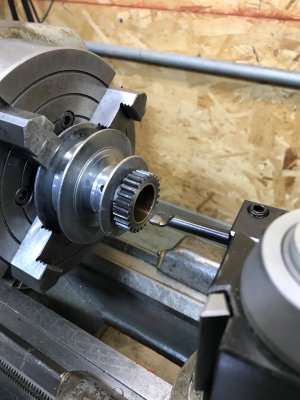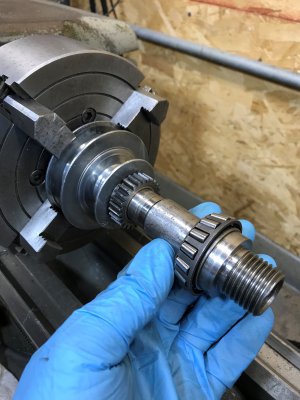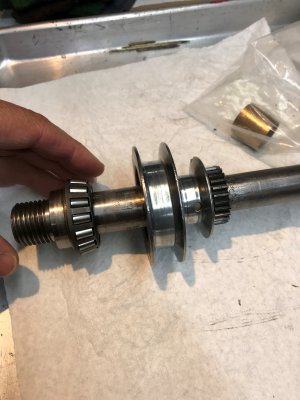- Joined
- Dec 25, 2011
- Messages
- 10,503
I can think of several ways to hold the pulley with the bushings installed but if the "holder" is going to be a 6" lathe, the only one that you have room for is going to be an expanding mandrel. And I suspect that it will take two mandrels as if you cut the mandrel to fit the bushings as they are now and bore out one bushing, the mandrel might be too small to hold without wobbling in the now larger ID bushing when you turn the pulley around to do the second bushing.
In any case, be sure that you use a carriage stop to prevent you from running the boring bar into the mandrel.
As far as how much to remove, first you need to accurately measure the spindle outside diameter in the region of the pulley and the inside diameters of the two bushings. Then you need to pick the class of fit, and look up what the clearance range should be. Reference pages 1540, top of 1541 and the table on page 1544 of the 21st edition of Machinery's Handbook. 1540 and 1541 define classes of fits. In my opinion, the spindle pulley bushings and spindle need a class RC6 or RC7 fit, where "R" means Running and "C" means clearance. For a nominal shaft OD and bushing ID of 0.71" to 1.19", the clearance between the shaft and the bushing should be between 2.5 and 5.7 Thousandths. That's for a Class RC7 fit. RC6 is a little tighter. And for both classes, the clearance requirement increases and decreases with diameter. In any case, you are probably looking at more like removing 3 to 5 thousandths than 1 or 2 (but note that that is on the diameter, not per side). Which increases the probability that you will need two of the mandrels to do the job. Unfortunately, "I cut it off twice and it is still too short" is only funny in the comics. Fortunately, clearance here has no effect on machine accuracy and the Chinese mandrel sets are relatively cheap. Unfortunately, I have not seen the individual mandrels for sale.
In any case, be sure that you use a carriage stop to prevent you from running the boring bar into the mandrel.
As far as how much to remove, first you need to accurately measure the spindle outside diameter in the region of the pulley and the inside diameters of the two bushings. Then you need to pick the class of fit, and look up what the clearance range should be. Reference pages 1540, top of 1541 and the table on page 1544 of the 21st edition of Machinery's Handbook. 1540 and 1541 define classes of fits. In my opinion, the spindle pulley bushings and spindle need a class RC6 or RC7 fit, where "R" means Running and "C" means clearance. For a nominal shaft OD and bushing ID of 0.71" to 1.19", the clearance between the shaft and the bushing should be between 2.5 and 5.7 Thousandths. That's for a Class RC7 fit. RC6 is a little tighter. And for both classes, the clearance requirement increases and decreases with diameter. In any case, you are probably looking at more like removing 3 to 5 thousandths than 1 or 2 (but note that that is on the diameter, not per side). Which increases the probability that you will need two of the mandrels to do the job. Unfortunately, "I cut it off twice and it is still too short" is only funny in the comics. Fortunately, clearance here has no effect on machine accuracy and the Chinese mandrel sets are relatively cheap. Unfortunately, I have not seen the individual mandrels for sale.




